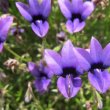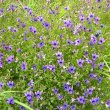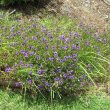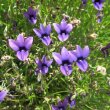| Botanical Name |
Monopsis unidentata subsp. unidentata |
| Family |
Campanulaceae - The Campanula family. |
| Pronunciation |
mon-OP-sis yoo-nih-den-TAY-tuh |
| Common Name(s) |
|
| Plant Group |
- Ground Cover A plant with a low-growing, spreading habit, grown specifically to cover the ground.
- Perennial A plant whose life cycle lasts for three or more seasons.
- Veld Flower Small veld flowers of interest, rather than for their usefulness in the garden. Some of these plants have garden potential, particularly for less formal garden situations.
|
| Plant Size |
- Small to Medium
| Tree | 8m to 15m |
| Shrub | 75cm to 1m |
| Perennial/ground cover | 20cm to 40cm |
| Bulb | 30cm to 40cm |
| Succulent | 20cm to 40cm |
|
| Position |
- Light or Dappled Shade Found below trees with sparse, open foliage. Ideal for the protection of herbaceous plants.
- Partial Shade The area is in shade for part of the day and in full sun for part of the day.
- Sun The area is in full sun for all or most of the day, all year round.
|
| General Information |
- Drought Tolerance: Moderate The plant is moderately adapted to arid conditions and can survive short periods of drought and high temperatures without extra water.
- Evergreen to semi-deciduous The plant is evergreen in warmer, wetter parts of the country, but may lose some of its leaves during winter in colder, drier situations.
- Frost: Tender A plant that will not survive any frost or low winter temperatures.
- Water Loving Plants need a regular supply of water and must not be allowed to dry out for any length of time.
- Water Moderate These plants will need some extra watering compared to water-wise plants. Plant them together, in at least some shade and in a convenient proximity to the house so that grey water can be utilised during times of drought.
|
| Specific Information |
Monopsis unidentata is a delightful, delicate looking, low-growing perennial with a preference for moist, sunny conditions. The small, serrated leaves leaves, which are bright green in colour, cluster around the base of the stems. The many soft, green stems lie along the soil and root at the nodes, forming low growing mats covered in dainty purple flowers. In the veld their stems creep and intertwine among wild grasses. The plant is little perturbed by cold weather as it dies down for a brief period during the winter months then shoots up again in the spring. It is unlikely to survive in climates where the ground freezes during winter.
A hybrid, 'Royal Flush', has been developed which is considered to be a great improvement, with lush, dense, foliage and masses of dark purple flowers lasting through summer and into autumn.
|
| Ad Break |
|
| Flowers |
| Description |
purple flowers with a deep purple throat, about 1 cm across with 5 petals, three of which point upwards and the other two pointing downwards, held at the tips of thin stems
|
| Season |
- Summer Plants will seldom bloom for the entire season as given in the list, but should flower during a period within these parameters.
|
| Colour |
|
| Growth Rate |
- Fast Specifying growth rate can be very misleading as there is considerable variation of growth rate depending on type and species of plant, available water, supplementary feeding, mulching and general care, as well as the plants suitability and adaptability to the garden environment.
|
| Plant Uses |
- Attracts bees, butterflies or other insects This plant attracts insects which can be food for birds or other creatures in your garden.
- Container Trees, shrubs and ornamental species that can adapt to growing in a restricted environment.
- Edging A low growing plant that provides softness or definition to the edges of a bed or walkway.
- Filler Either a fast growing tree or shrub used temporarily to fill in an area while the permanent plants grow to a desired size, or a plant used to fill gaps in borders or beds.
- Ground Cover Low-lying plants that spread fast, require minimal maintenance, and cover large expanses or bare areas between bulbs or shrubs. They provide protection from erosion and drought and improve the visual appearance of the garden.
- Interplanting Arranging and planting plants in the garden that have different blooming times and habits of growth, extending the amount of time in which the area is in flower.
- Pot Plant A plant that needs a protected environment on a patio or indoors.
- Suitable for coastal gardens Plants adapted to dry, sandy soil, forceful wind, limited rainfall and intense sunlight.
- Water Features These plants may have dramatic, lush foliage or graceful form. They do not shed excessive leaves and do not have invasive root systems.
- Wetland
An area of land that is saturated with fresh or salt water and is a distinct ecosystem, with plants and wild life specifically adapted to and dependent on, a bog, fen, march or swamp.
- Wild Garden An indigenous garden planted for the benefit of wildlife and birds. Provides food, water, a variety of mini-biomes and no poisonous chemicals are used.
|
| Distribution and Habitat |
slightly inland from the coast, from the southern part of the Western Cape, through the Eastern Cape to the south of KwaZulu-Natal, in damp, sandy flats, among grasses and on rocky slopes
|
| Planting Suggestions |
Monopsis unidentata has a preference for moist areas but will grow in gardens if the soil is kept damp all year round. It is easily propagated from rooted cuttings that can be taken at any time of the year. Space the plants about 30 cm apart to create a dense ground cover. Soil should be well composted and an occasional application of 3:1:5 slow release fertilizer can be used to improve growth and flowering.
|
| Medicinal Uses |
|
| Ad Break |
|








Discuss this plant
Share knowledge, ask a question or give an experience.